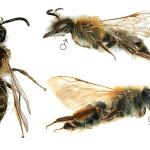Restricted to the south-eastern corner of England (East Sussex, Kent and Essex), where records have always been sporadic. Unconfirmed records exist for Hampshire and West Sussex.
Widespread and common in central and southern Europe.
Listed in Shirt (1987) and Falk (1991) as Endangered (RDB1). It has been included in the UK Biodiversity Action Plan Priority Species List.
May be found in a variety of open habitats with a slight preference for clay-based or sandy soils, although these need not be acidic.
Univoltine; April to May, although two males collected in Kent by J C Felton during July and August may represent a partial second generation.
May nest singly or in small aggregations in patches of bare, or sparsely vegetated soil exposed to the sun (M Edwards, pers. obs. in the Netherlands; Westrich 1989).
Those of a wide range of plants, as long as the corollae are short.
No parasites are known in Britain.
2002


